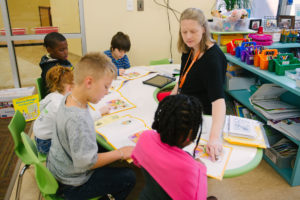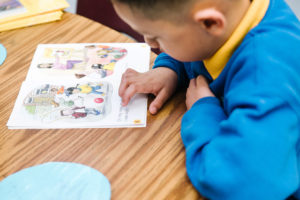
Lenora Forsythe

Tamara Williams
We’re delighted to feature this blog post co-authored by fifth-grade teacher and reading interventionist Tamara Williams and former reading coach and first- and third-grade teacher Lenora Forsythe of Collaborative Classroom.
Together Tamara and Lenora bring a collective thirty years of experience teaching and coaching reading.
Our intent as teachers is to ensure mastery of skills—especially when it comes to foundational skills—using data-informed instruction. The challenges of this school year have underscored the need for data-informed instruction to accelerate student learning, as we think about not only intervening, but literally making up for lost time. As we approach the midyear mark, it’s important to pause and consider what data we have now and how we’re using that data to adjust instruction to meet our students’ needs.
 Our collective experience includes teaching and coaching reading with a variety of student and adult learners, so when asked to write about our “go-to” moves for data-informed practices, Lenora and I were excited to collaborate on the data we consider and how we use it to make instructional decisions.
Our collective experience includes teaching and coaching reading with a variety of student and adult learners, so when asked to write about our “go-to” moves for data-informed practices, Lenora and I were excited to collaborate on the data we consider and how we use it to make instructional decisions.
Practice #1: First, Look Within
When we think about foundational skills instruction, there are many known best practices based in the science of reading. We know students need to be highly engaged in systematic, explicit instruction. We know students need ample practice. We also know that early intervention matched to each individual’s point of need is essential. Finally, we know that students benefit from consistent, clear instruction.
Considering these “knowns,” our first recommendation is to ensure that what is happening during instruction does in fact align with these best practices. Before digging through student data and assuming instruction is not working or suspecting a learning disability, we suggest that you ask yourself the following questions:
- Am I following a systematic progression of instruction?
- Is my instruction targeted to meet a known gap/deficit?
- Has my instruction been explicit? Consistent? How do I know?
- As an interventionist, what do I know about core instruction? Is my instruction aligned to core? Is the core instruction effective?
- Have students had ample time to practice recently taught skills?
If the answer to any of these questions is “No” or “I’m not sure,” this is the perfect opportunity to delve deeper into current instruction by engaging in self-reflection to ensure you are teaching in alignment with best practices.
Practice #2: The Power of Observation
Observing. Kid-watching. Anecdotes. No matter how formal or informal, having a keen eye on what students are doing (or not doing) is an essential part of data collection.
Between ourselves, we’ve joked that this is sort of a mini self-challenge—we want our observations to provide a solid prediction for upcoming progress-monitoring data. By using our observations, we can proactively add in additional practice of the skills we see lacking before a formal data collection opportunity. Here are some things to look for during the literacy block:
- Reading tasks: Is the child able to decode patterns and read sight words that were previously taught? Are they able to do this in isolation and in connected text? Is the child able to read at the expected rate with high accuracy?
- Writing tasks: Is the child able to spell previously taught sight words and spelling patterns?
Practice #3: Observing During Instruction Itself
The kid-watching continues—in all honesty, it never stops!— but with a new layer. During actual instruction, our observation skills intentionally shift and expand to encompass what’s happening within the lesson. As described in Practice #2, we continue to note how students are doing as they practice recently introduced reading and spelling skills. Now, during direct instruction, an additional layer of observation comes in. Here are some of the things we look for:
- We watch for mouth movements and eye contact that signal that our students are in the moment with us.
- We use proximity to support attention as needed. For example, during choral responses, we still attempt to lean in to each student individually so we can listen carefully as they respond.
- During virtual instruction, we ask students to sit on the edge of their seats, with their bodies and cameras poised for optimal viewing of mouth movements and/or writing observations.
- We also lean in to listen and watch as students apply what they have learned to reading decodable text and spelling during dictation tasks.
Our observations during direct instruction allow us to be more responsive, supplementing with additional practice when any observational data indicates the need for it. Then, when the time comes, we collect individual student progress monitoring data that brings us back to our original goal: mastery of foundational skills.
 This data will inform our decision-making—it helps us decide if we keep moving along with the systematic progression of instruction at the same pace, continue instruction at a slower pace, or return to reteach previously taught skills. It will tell us if the whole group should move on, or if only some students are ready to do so.
This data will inform our decision-making—it helps us decide if we keep moving along with the systematic progression of instruction at the same pace, continue instruction at a slower pace, or return to reteach previously taught skills. It will tell us if the whole group should move on, or if only some students are ready to do so.
Practice #4: Observing Across the School Day
Our next tip? That’s right! Kid-watching. But this time, we suggest you look beyond the isolated instructional time that’s devoted to foundational skills and really consider what you see students doing across the entire school day. (If you are in an interventionist role and only work with students for a short part of the day, this may mean asking the child’s homeroom teacher to provide artifacts or to share observations with you.)
While it’s essential that our students master foundational skills, that mastery is always in service of a bigger, overarching goal: developing our students as well-rounded readers.
While it’s essential that our students master foundational skills, that mastery is always in service of a bigger, overarching goal: developing our students as well-rounded readers. To that end, we encourage you to lean in and listen as students engage in independent reading. Are they applying what they know to be true in lessons to their leisure reading? Are they accurate? Fluent? Take a close look as they write. Are they applying what they have learned about words to their drafts?
Pay attention to other content areas, as well. Do you notice application of these reading and writing skills during math? Science? Social Studies? In addition to observational data, consider student performance on additional outcome measures that help you look at each child as a whole reader. What is the big picture telling you?
Practice #5: Invite a Thought Partner
When in doubt, phone a friend. Whether you’ve been teaching for one year or for decades, the value of a thought partner cannot be overstated. Sometimes student data is perplexing, and the fresh perspective of a colleague can help draw attention to certain areas, or help prioritize instruction.
In our experience, thought partnerships have proven especially helpful in situations where the data doesn’t point to a specific skill (e.g., the child is having difficulty with the short e sound), but instead points to a few weaknesses. It helps to think through the instructional approach with a colleague: Would inserting extra practice be enough? Is reteaching warranted? After I insert extra practice or reteach, should I adjust the pacing on upcoming lessons? When should I remove the scaffold(s)?
In addition to having a colleague with whom to collaborate, a research-based intervention curriculum can serve as a partner and support for your data-informed instructional decision-making. For example, in the SIPPS program that we use, teacher supports such as Instructional Self-Checks and Mastery Test Interpretation guidance are embedded within the program materials. These supports have helped us individually and in collaboration with others to analyze student data and ensure we are well-informed for determining instructional next steps.
In Conclusion: Working Efficiently Toward Mastery
So there you have them: our top five practices for data-informed foundational skills instruction. Before we conclude, here are a few final words of encouragement as you embark on this work:
- Embrace the individuality of each student.
- Appreciate the wealth of information that is available to triangulate—within lessons and beyond—to paint a clear data story for each child.
- Take time to hone your kid-watching skills.
- Give yourself grace, always, as you continue to learn and grow!
In navigating this unique school year, we believe that a focus on data-informed instruction will help you and your students work more efficiently toward mastery of foundational skills. By relying on comprehensive data collection, we ensure that our time teaching is spent on exactly what students need most. When it feels overwhelming, keep in mind that growth can happen quickly, especially when instruction is tailored, and there is nothing more rewarding than seeing all the pieces come together for your readers!
***
To hear more from Tamara and Lenora, view their recent on-demand webinar “Using Data to Inform Our Response: Grouping and Instructional Decision Making in Foundational Skills Instruction.”
